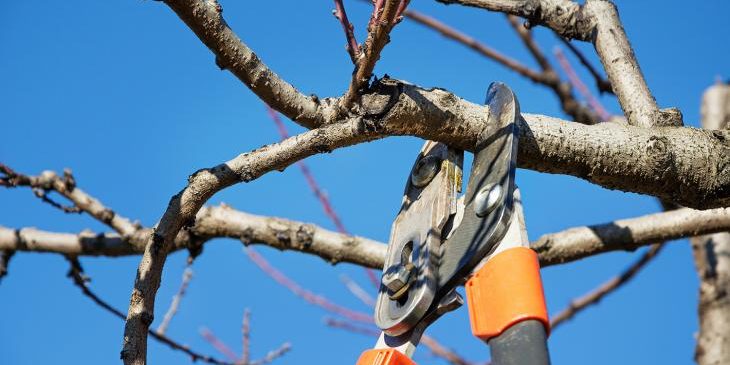Fruit tree pruning is not just a horticultural practice; it’s an art and a science that significantly impacts the health and productivity of your fruit trees. Pruning helps in shaping the tree, ensuring that sunlight and air can reach the inner branches, and promotes the growth of new fruiting wood.
Benefits of Pruning for Fruit Trees
Regular fruit tree pruning leads to higher fruit quality, prevents the spread of diseases, and maintains the tree’s overall health. It’s essential for the longevity of your fruit orchard and for ensuring bountiful harvests year after year.
Overview of Tools and Safety Measures
Before diving into fruit tree pruning, it’s crucial to understand the tools required and the safety measures to adhere to. The right tools not only make the job easier but also ensure cuts are clean and precise, which is vital for the tree’s health.
The Basics of Fruit Tree Pruning
Identifying the Right Time to Prune
Timing is crucial in fruit tree pruning. Most pruning is done during the dormant season (late winter to early spring), before new growth begins. However, the specific timing can vary depending on the type of fruit tree.
Different Types of Fruit Trees and Their Pruning Needs
Each type of fruit tree has unique pruning requirements. Apple trees, for instance, benefit from a central leader system, whereas stone fruits like peaches are often pruned in an open vase shape.
Pruning Techniques: An Overview
Two primary cutting techniques are used in fruit tree pruning: heading cuts (shortening branches) and thinning cuts (removing branches at their point of origin). Proper use of these techniques is crucial for effective pruning.
Tools and Equipment for Pruning
Choosing the Right Pruning Shears
For most fruit tree pruning tasks, a pair of sharp, bypass pruning shears is ideal. They make clean cuts that heal quickly and minimize damage to the tree.
Ladders and Safety Equipment
Safety is paramount when pruning. Use a sturdy ladder for reaching higher branches, and always wear protective gloves and eyewear to safeguard against injuries.
Maintenance and Care of Pruning Tools
Keeping your pruning tools clean and sharp is essential. After each use, clean the blades to prevent disease spread and sharpen them regularly to ensure precise cuts.
Pruning Young Fruit Trees
Establishing a Strong Framework
In the early years, fruit tree pruning focuses on developing a strong, balanced framework of branches. This sets the stage for the tree’s future growth and fruit production.
Training Trees for Optimal Growth
Training young trees involves directing their growth to ensure a strong structure. This might include staking or using ties to guide branches into the desired shape.
Early Pruning Mistakes to Avoid
Over-pruning can be detrimental to young trees. It’s important to prune just enough to shape the tree and encourage growth, without removing too many branches.
Pruning Mature Fruit Trees
Assessing the Tree’s Health and Shape
When it comes to mature fruit tree pruning, start by assessing the tree’s overall health and shape. Look for dead, diseased, or damaged branches that need removal.
Removing Dead, Diseased, or Damaged Branches
These branches not only affect the tree’s appearance but also its health. Removing them is a critical step in fruit tree pruning.
Thinning for Light and Air Circulation
Thinning out crowded branches improves light penetration and air circulation, which is essential for fruit quality and reducing disease incidence.
Seasonal Pruning Practices
Winter Pruning for Vigorous Growth
Winter is the ideal time for major pruning. Removing branches during dormancy encourages vigorous growth in the spring.
Summer Pruning to Control Size
Summer fruit tree pruning is mainly for size control and correcting growth issues. It’s also the time to remove water sprouts and suckers that sap the tree’s energy.
Understanding the Needs of Different Seasons
Each season has its pruning objectives. Understanding these will guide you in making the right pruning decisions throughout the year.
Specialized Pruning Techniques
Espalier Training
Espalier is a technique where trees are trained to grow flat against a structure. It’s not just aesthetically pleasing but also space-efficient, making it an excellent option for smaller gardens.
Topiary Art in Fruit Trees
Topiary involves shaping trees into artistic forms. While it’s more common in ornamental gardening, it can be applied to fruit trees for a unique landscape feature.
Regenerative Pruning for Older Trees
Older trees that have been neglected can benefit from regenerative pruning. This involves removing large amounts of growth over several years to rejuvenate the tree.
Disease Management Through Pruning
Identifying Signs of Disease and Pest Infestation
Part of effective fruit tree pruning involves being vigilant about signs of disease and pest infestation. Look for discolored leaves, damaged bark, or unusual growths, as these can indicate health issues.
Pruning as a Preventative Measure
Regular pruning helps in disease management by removing parts of the tree that are infected or susceptible to infection. Opening up the canopy reduces the humidity levels around the branches, which can deter certain pests and diseases.
Post-Pruning Care for Disease Control
After pruning, it’s important to take care of the open wounds. Use pruning sealants if recommended for your specific fruit tree type to protect against infections and pests.
Pruning for Fruit Quality Improvement
Balancing Fruit Load for Better Quality
One of the goals of fruit tree pruning is to balance the fruit load. This ensures that the tree doesn’t become overburdened with fruit, which can reduce overall quality. By selective pruning, you encourage the development of larger, healthier fruits.
Encouraging Fruit Size and Sweetness
Pruning can also impact the size and sweetness of the fruit. By reducing the number of fruits that a tree bears, you can channel more of the tree’s resources into producing fewer, but higher-quality fruits.
Techniques for Increasing Yield
While it seems counterintuitive, proper pruning can increase the overall yield of your fruit trees over time. By maintaining the health of the tree and ensuring good light exposure, you can boost its fruit-bearing potential.
Composting and Utilizing Pruning Waste
Turning Pruning Waste into Compost
Don’t let your pruning waste go to waste. Turn it into compost instead! Chipping small branches and leaves can create nutrient-rich material that can be used to enrich your garden soil.
Mulching with Pruning Debris
Pruning debris can also be used as mulch around the base of your fruit trees. This not only recycles the waste but also helps in retaining soil moisture and suppressing weeds.
Eco-friendly Disposal of Waste
For larger branches and non-compostable materials, consider eco-friendly disposal methods. Check with local waste management services for green waste recycling options.
Advanced Tips and Common Mistakes
Understanding Rootstock Influence on Pruning
The type of rootstock your fruit tree is grafted onto can influence how it should be pruned. Some rootstocks encourage vigorous growth, while others are dwarfing. This knowledge can guide your pruning decisions.
Mistakes That Can Harm Your Fruit Trees
Common mistakes in fruit tree pruning include over-pruning, improper cut placement, and pruning at the wrong time of the year. Avoid these to ensure the health and productivity of your trees.
Continuous Learning and Improvement in Pruning
Fruit tree pruning is a skill that improves with practice and learning. Attend workshops, consult with local experts, and continuously observe the response of your trees to your pruning decisions.
Frequently Asked Questions (FAQs)
When is the best time to prune fruit trees?
The ideal time for fruit tree pruning is during the dormant season, typically late winter to early spring before new growth starts. However, timing can vary slightly based on the type of fruit tree and local climate.
How often should fruit trees be pruned?
Most fruit trees benefit from annual pruning. Regular pruning maintains the tree’s health, encourages fruit production, and helps manage its size and shape.
Can pruning help increase fruit yield?
Yes, proper pruning can significantly increase fruit yield. It helps in removing dead or diseased wood, encourages the growth of new fruiting spurs, and ensures better sunlight penetration and air circulation.
What are the essential tools for fruit tree pruning?
Essential tools include a pair of sharp bypass pruning shears, loppers for thicker branches, a pruning saw for large branches, and a sturdy ladder for taller trees. Always ensure tools are clean and sharp.
How do I know which branches to prune?
Focus on removing dead, diseased, or damaged branches, branches that cross or rub against each other, and any suckers or water sprouts. Aim to create an open canopy that allows light and air to penetrate.
Is it necessary to seal pruning cuts?
Generally, it’s not recommended to seal pruning cuts, as trees are capable of sealing their wounds. Sealing can sometimes trap moisture and lead to disease.
Can I prune fruit trees in summer?
Yes, light pruning can be done in summer to remove vigorous growth, like water sprouts, or to shape the tree. However, major pruning should be reserved for the dormant season.
What are the common mistakes to avoid in fruit tree pruning?
Common mistakes include over-pruning, making improper cuts, pruning at the wrong time of year, and not sterilizing tools between cuts on different trees.
How should I care for my fruit trees after pruning?
After pruning, clean up all debris to prevent disease spread. Water the trees adequately, and consider a balanced fertilizer to support new growth, following local agricultural guidelines.
What is the difference between pruning young and mature fruit trees?
Pruning young fruit trees focuses on establishing a strong structure and framework while pruning mature trees is more about maintenance, fruit production, and health.
Conclusion
In conclusion, mastering fruit tree pruning is essential for anyone looking to maintain healthy and productive fruit trees. It’s a skill that requires understanding, patience, and practice.
Proper fruit tree pruning results in healthier trees, improved fruit quality, and increased yields. It’s an investment in the future of your orchard.
Whether you’re a home gardener or an orchard owner, the benefits of implementing these fruit tree pruning practices are immense. With the right knowledge and tools, you can ensure the health and productivity of your fruit trees for years to come.





